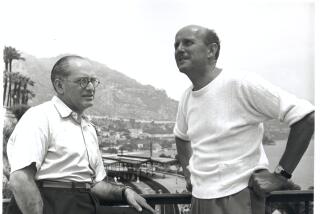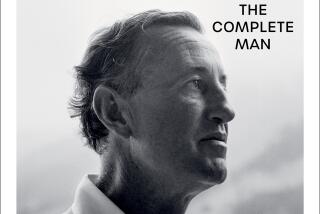The manly wizard of ‘Oz’ and Tara
Victor Fleming strides through Michael Sragow’s eponymous biography with the panache of Rhett Butler -- and no wonder, since the director helped forge Clark Gable’s onscreen persona with “Red Dust” and “Test Pilot” years before they reunited for “Gone With the Wind.”
Appreciatively chronicling Fleming’s work on these and other classic films, including “The Virginian,” “Treasure Island,” “Captains Courageous” and “The Wizard of Oz,” Sragow -- who is a film critic at the Baltimore Sun -- portrays his subject as a man’s man who enjoyed fishing, hunting, flying airplanes, riding motorcycles, driving fast cars and making love to beautiful actresses.
In Sragow’s view, Fleming’s extracurricular activities enhanced his stature on the set: “Actors felt energized by the sight of this tall, powerfully built figure reflexively brushing back his mane and training a sharpshooter’s vision on their performances. . . . Craftsmen felt secure serving a director who could correct errors on the run, from lax ad libs to skewed camera angles.”
Sragow is eager to rescue Fleming from his posthumous reputation as a studio hack. This image grew from the troubled production histories of his two most famous movies.
Fleming assumed command of both “The Wizard of Oz” and “Gone With the Wind” after shooting had begun. In the 1970s, Aljean Harmetz’s “The Making of ‘The Wizard of Oz’ ” and Roland Flamini’s “Scarlett, Rhett, and a Cast of Thousands” implicitly credited producers Mervyn LeRoy and David Selznick, respectively, as the primary guiding forces of those films.
Sragow begs to differ. Indeed, by the time we get to “The Wizard of Oz” and “Gone With the Wind,” which were shot in 1938 and 1939, he has amply made his case that the director was much more than a competent craftsman.
Fleming, born in Southern California in 1889 and raised in modest comfort in a family of citrus ranchers, quit school at 14 and soon was working as a machinist for an automobile dealer. His mechanical abilities got him into the fledgling movie business.
By 1917, he was a highly regarded cinematographer for Douglas Fairbanks, whose emphasis on physical action reinforced Fleming’s understanding that motion pictures needed to move. Fairbanks gave Fleming his first chance to direct in 1919.
Sragow’s able coverage of Fleming’s early movies shows the director honing his technical skills, collaborating closely with experienced screenwriters like Anita Loos, and tenderly showcasing rising stars like Norma Shearer and Clara Bow, who both gave career-making performances for him -- and fell for him too, as did most of his leading ladies.
Yet he was no callous Lothario: “Fleming’s conquests would be legion,” writes Sragow, “but they always spoke of him as a man who took good care of them.”
He continued to take good care of his actors after he made the transition to talking pictures and began a long association with MGM in 1931.
Gable and Jean Harlow got their best roles to date in “Red Dust,” and Harlow was never funnier than in “Bombshell.” Filming “Treasure Island” and “Captains Courageous,” he treated child actors Jackie Cooper and Freddie Bartholomew with the same respect he showed adults.
The brutal eight-month period during which Fleming shot “The Wizard of Oz” and “Gone With the Wind” back-to-back tested him to the limit, and Sragow acknowledges that he was occasionally uncharacteristically impatient and ill-tempered on the set. But he also cites many actors, including the notoriously high-strung Judy Garland (although not the equally high-strung Vivien Leigh), who found Fleming considerate and courteous.
For virtually every film Fleming directed, Sragow provides detailed descriptions and analyses. These are a mixed blessing; they slow the narrative but also create a richly textured portrait of the movie industry and Fleming’s ability to operate within its constraints.
Like his pal Howard Hawks, Fleming was comfortable in many genres: screwball comedy, action/adventure, westerns, even literary adaptations. He could meet the studio’s commercial imperatives while crafting adult entertainment and family fare that didn’t scant emotional complexity.
He had his share of flops, but the only unmitigated disaster was his final film, “Joan of Arc,” a lifeless epic whose star, Ingrid Bergman, was also one of the producers -- and in the midst of a passionate affair with Fleming. The rigors of the production may well have contributed to his death from heart failure at age 59, less than two months after the movie’s premiere.
Sragow quotes warm tributes from friends and colleagues dating back to the silent era, buttressing the point that Fleming was beloved for his personal qualities as well as esteemed for his artistry.
If this romantic, larger-than-life portrait sometimes seems a little too good to be true, it’s backed by ample documentation and a list of credits that remind us just how many of the Hollywood studio system’s most iconic films bore Victor Fleming’s imprimatur.
More to Read
Only good movies
Get the Indie Focus newsletter, Mark Olsen's weekly guide to the world of cinema.
You may occasionally receive promotional content from the Los Angeles Times.










